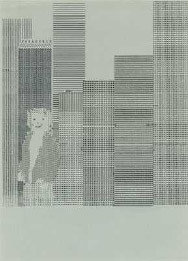Simone Schardt
dal 30/5/2008 al 5/7/2008
Segnalato da
30/5/2008
Simone Schardt
Galerie Christian Lethert, Koln
Double Exposures. Both the large-sized drawings performed with a felt tip pen and the series of typewriter drawings refer to ambiguities, which are contained in the gestures of exposure.

The drawings of the artist Simone Schardt, who lives in Zurich, hold different interpretation purposes. Made on a material, which carries its own narration and meaning, speech and image cross each other in accumulations of scientific and cultural artefacts: notations of test arrangements and pop cultural fragments interfere with each other; perceptions of nature get overlaid with manifestations of indescribable boredom; letters accumulate to formations of images. Simone Schardt presents in her first solo exhibition (entitled “Double Exposures”) at the Galerie Christian Lethert works, in which the relation of the beholder and the viewed object appears as calling for each other. Both the large-sized drawings performed with a felt tip pen and the series of typewriter drawings refer to ambiguities, which are contained in the gestures of exposure, which point at objects and say “Look!” and at the same time, with the authority of those who are in the know, state “That’s the way it is.”
Resulting from her occupation as a molecular biologist there exist many records on continuous paper, whose curve progression and meticulous notation of their boundary conditions should shed light on the success or failure of an enzymatical reaction. These records were reworked by the artist for a second time. Contrasted by song fragments, which very clearly formulate a desire, now the disconnection between the subject and the object of its research begins to collapse: Not only is the searching subject looking at the object through its instruments of empiric observation, such as microscopes, monitors, test tubes, but also is the object looking back. Not only the beholders see an image, but they are themselves already perceived by the view inherent to the object. In this double exposure the epistemological configuration, which the diagrammatic surface of the drawings stands for, gets deeply disturbed.
The typewriter drawings shall very pointed represent the production methods of the Conceptual Art in the 1960/70s – a period in which the knowledge of psychoanalysis influenced a knowing artistic production – and hereby satirize a blank space of that, what emerged as a result of the conceptual methods: the artistic and curatorial relationship within the scope of that, what goes down in modern art historiography as “Institutional Critique”. The figurative presentation by letters, hyphens and commas of drawing “Gianni in NY” (2007) dissolves into the different significance level of a non abstract situation: The young curator is standing in front of an impressive skyline (the title refers to New York), just the illuminated advertising is integrating the situation in an everyday standard by its appeal to the people as potential producers or consumers
Galerie Christian Lethert
Antwerpener Strabe, 4 - Colonia



